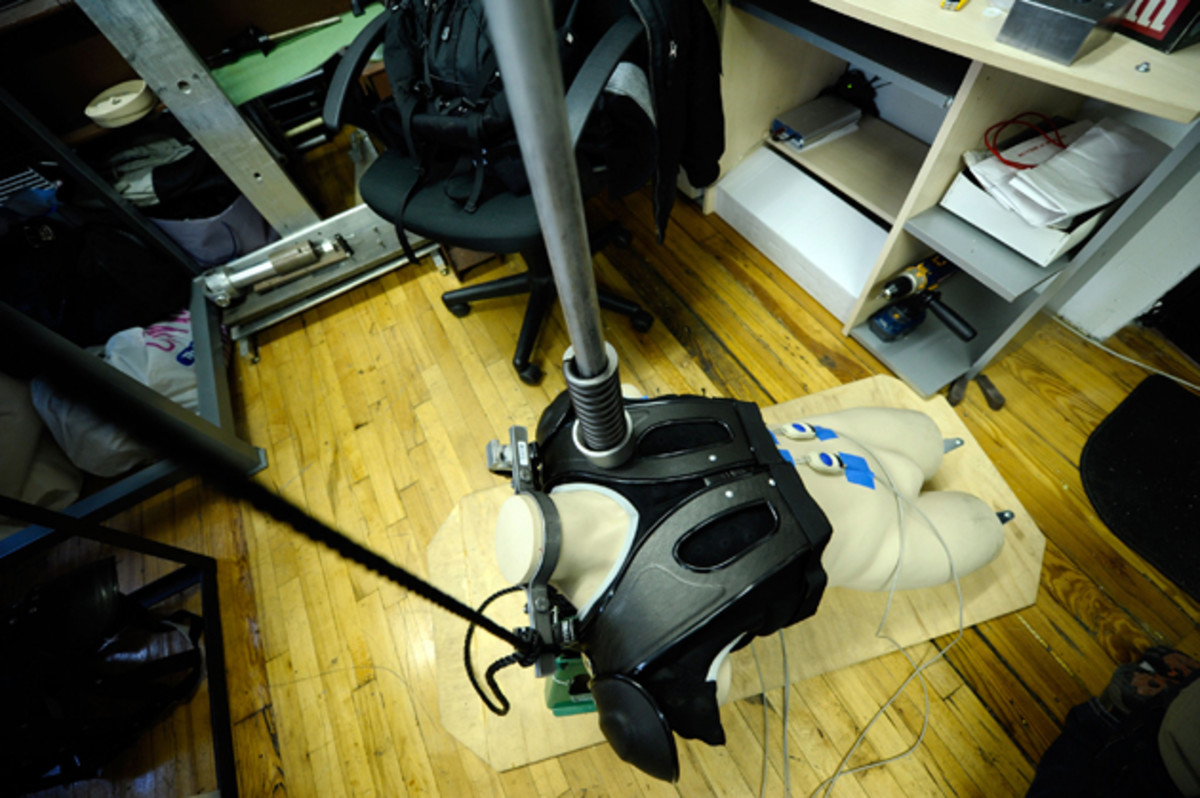Russell Athletic Releases New Carbon Fiber Shoulder Pads

A carbon-fiber exoskeleton paired with a compression vest featuring automotive-grade foam was the most high-tech way Russell Athletic could devise to enter the world of shoulder pads. Hey, they even added in a “military-grade buckle system.”
“There hasn’t been a lot of change in this category in a long time,” Sarah Gholston, Russell’s vice president of design and development, tells Edge in the exclusive debut of the Kentucky-based company’s pad system. “We wanted to do something different. Every major component on this pad is not seen in the industry today.”
So much difference; so many high-end materials. Let’s start from the outside.
MORE: Super Yarn: Nike's Footwear Material for the Future
CarbonTek, with the OS Technology shoulder pad system, features a carbon fiber shell, covering the chest, shoulders and back—a first for shoulder pads. Russell built in differing layers of carbon, with increased thickness in high-impact areas (Russell wouldn’t divulge layering specifications with their patent-pending product) for amped up protection.
Mark Ingram, former Heisman Trophy winner and current running back for the New Orleans Saints, tells Edge wearing the new Russell pads gives him a real sense of explosion and protection.
“I didn’t feel much of the impact when I had big collisions,” he says. “They absorb so much of the force from the hits that I’ve experienced.”

Ingram has worn the pads during training and will don them during NFL games for the first time in the upcoming season, touting the fit in the lead-up to the season. “Previously, when they gave you pads, you just wanted the pads that fit you best,” he says. “If they were too big and bulky you couldn’t turn your head or lift your arms. While not technically molded to your body, I love how the OS Technology fits. They are very snug and light, not bulky. It feels really protective.”
MORE: ’Tis Better to Give: Riddell's New Helmet Flexes to Protect
According to Gholston, the high strength of aerospace-grade carbon fiber couples with the material’s lightweight build to give these pads a 10 percent reduction in weight when compared against most pads, but with more protective coverage.
Also a first in the shoulder pad world, the carbon fiber shell fully detaches—the placement of it can be adjusted to custom-fit athletes—from the foam-filled compression vest, allowing players to wear just the vest for light protection during non-contact drills.
The vest—also featuring odor and heat management materials—expands beyond a typical shoulder pad and fills with dual-density foam, with the soft foam against the body and harder foam on the outside.
“You can feel the difference,” Gholston says. “There is more comfort toward the body and more protection on the outside.”
MORE: Storelli is Redefining Soccer Protection Gear
Using the larger shape, the pad’s surface area helps disperse impact force, as do the holes throughout the foam. Russell’s independent lab testing supports their claims, but it was field-testing in Fall 2013 with Division I schools that really solidified the CarbonTek system. Russell distributed 85 pad systems throughout the country, including some in use during the National Championship game on the shoulders of University of Auburn starters.
“From the (compression) vest itself, the combination of foam, the shape of the foam and its ability to stretch and the strength of the carbon fiber gives us even more energy dispersion when we put them together,” Gholston says. “The players say they knew they were getting hit, but couldn’t feel exactly where and that makes it easier to recover from. This validates the claims from (sports equipment scientist) Dr. Richard Brandt’s lab that the system disperses energy over the whole body of the pad.”
In those lab tests, CarbonTek outperformed other shoulder pads tested in all assessed aspects of impact dispersion, including more than a 63 percent reduction in the average force felt through the CarbonTek system in a 600-pound impact test, Brandt's study says.
The final version of the pad system will start to ship in July and August, hitting the backs of Division I schools and NFL players, such as Ingram and Pierre Garcon.
Russell wanted to do something different for shoulder pads. It was about time.
Tim Newcomb covers stadiums, design and gear for Sports Illustrated. Follow him on Twitter at @tdnewcomb.
